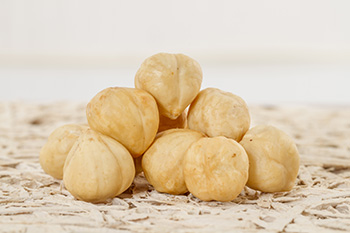Hazelnut and Health
Hazelnut has an important place among the dried fruits for human diet and health in featuring a special combination of fatty oil (mostly oleic acid), protein, carbohydrate, vitamins (vitamin E), minerals, diabetic fibers, phytosterol (beta-sitosterol) and antioxidant phenolic.
Nutritive and sensational properties of hazelnut make it a unique and ideal material for food products. Since they contain fat at 60,5%, making hazelnuts a good energy source.
Many researchers asserted that consumption of hazelnut has a positive effect on the human health. These effects may be related with fatty acid profile of hazelnut lipids which is rich in mono- and poly- unsaturated fatty acid (82,8% oleic and 8.9% linoleic).
 As demonstrated by the studies, the dietary regime which is low in saturated fatty acids and high in mono-unsaturated fatty acids (MUFA) is effective under the control of level of blood lipids; a similar result, it may be a positive effect on the risk of coronary hearth disease (CHD). Also, the dietary regimes enriched with MUFA (as contained in hazelnut oil at the high levels) creates positive impacts on humans such as lessened CHD cases, hypotension, lowered total cholesterol balance, lowered lipoprotein levels (LDL) or reduced values of blood triglyceride.
As demonstrated by the studies, the dietary regime which is low in saturated fatty acids and high in mono-unsaturated fatty acids (MUFA) is effective under the control of level of blood lipids; a similar result, it may be a positive effect on the risk of coronary hearth disease (CHD). Also, the dietary regimes enriched with MUFA (as contained in hazelnut oil at the high levels) creates positive impacts on humans such as lessened CHD cases, hypotension, lowered total cholesterol balance, lowered lipoprotein levels (LDL) or reduced values of blood triglyceride.
In terms of Vitamin E, hazelnut is the best second source after vegetable oils. Vitamin E is a soluble lipid phenolic antioxidant. The antioxidant actions of phenolics come from its ability to convert hydrogen atoms into individual roots. Since these compounds can create individual roots, they are believed to have a potential in preventing cancer and atherosclerosis in patients suffering from diabetes. Due to the antioxidant role of Vitamin E and its relationship with coronary heart disease and cancer, the popularity of natural food products which also include hazelnut and hazelnut products has been growing among consumers and industry.
 Eating just 25-30g of hazelnut everyday meets 100% of the daily need for Vitamin E. As demonstrated by the recent studies, beta-sitosterol abundantly contained in the hazelnut can play a significant role in preventing many diseases such as cancer (colon, prostate, breast) as well as reducing the cholesterol. This is also valid for inhibiting the tumor growth and apoptosis excitation. Hazelnuts are also a good mineral source, notably of calcium, magnesium, phosphor and potassium. Besides balancing the blood pressure, hazelnuts low in sodium but generous in minerals has a great significance for bone development and health. These minerals are well-known to have positive effects on the health.
Eating just 25-30g of hazelnut everyday meets 100% of the daily need for Vitamin E. As demonstrated by the recent studies, beta-sitosterol abundantly contained in the hazelnut can play a significant role in preventing many diseases such as cancer (colon, prostate, breast) as well as reducing the cholesterol. This is also valid for inhibiting the tumor growth and apoptosis excitation. Hazelnuts are also a good mineral source, notably of calcium, magnesium, phosphor and potassium. Besides balancing the blood pressure, hazelnuts low in sodium but generous in minerals has a great significance for bone development and health. These minerals are well-known to have positive effects on the health.
Hazelnut also contains all necessary amino acids as well as minerals. Hazelnut can also be used as a protein source together with pulse-origin foods which is low in cysteine and methionine. As stated above, hazelnut is a good source in terms of natural antioxidants. This indicates nutraceutical potential of hazelnut and hazelnut products. Consequently, hazelnut is a vital nutrition and ingredient for a balanced daily diet and the most beneficial nutraceutical substance in terms of health of heart. Eating a handful of hazelnut daily may protect you against many diseases as stated above.
Energy and Nutrition Facts
Energy and Nutrition Facts for Roasted Hazelnut Kernels
| ENERGY AND NUTRITION FACTS | Value for 100 g | ||||
|---|---|---|---|---|---|
| Energy | 646 | kcal | Total fat | 59.5 | g |
| Protein | 15 | g | Saturated fat | 4.5 | g |
| Carbonhydrate | 17.6 | g | Monounsaturated fat | 46.6 | g |
| Fiber, total dietary | 9.4 | g | Polyunsaturated fat | 8.4 | g |
| Sugars, total | 4.9 | g | Cholesterol | 0 | mg |
| Minerals | Vitamin | ||||
| Calcium, Ca | 123 | mg | Vitamin C, ascorbic acid | 3.8 | mg |
| Iron, Fe | 4.4 | mg | Thiamin | 0.3 | mg |
| Magnesium, Mg | 173 | mg | Riboflavin | 0.1 | mg |
| Phosphorus, P | 310 | mg | Niacin | 2 | mg |
| Potassium, K | 755 | mg | Vitamin A, IU | 61 | IU |
| Zinc, Zn | 2.5 | mg | Vitamin E | 15.3 | mg |
| Manganese, Mn | 5.6 | mg | Vitamin B-6 | 0.6 | mg |
| Selenium, Se | 4.1 | mg | Pantothenic Acid | 0.9 | mg |
| USDA Nutrient database for Standard reference, release 20 (2007) | |||||
Energy and Nutrition Facts for Natural Hazelnut Kernels
| ENERGY AND NUTRITION FACTS | Value for 100 g | ||||
|---|---|---|---|---|---|
| Energy | 628 | kcal | Total fat | 58 | g |
| Protein | 15 | g | Saturated fat | 4.5 | g |
| Carbonhydrate | 16.67 | g | Monounsaturated fat | 45.6 | g |
| Fiber, total dietary | 9.7 | g | Polyunsaturated fat | 7.9 | g |
| Sugars, total | 4.3 | g | Cholesterol | 0 | mg |
| Minerals | Vitamin | ||||
| Calcium, Ca | 114 | mg | Vitamin C, ascorbic acid | 6.3 | mg |
| Iron, Fe | 4.7 | mg | Thiamin | 0.6 | mg |
| Magnesium, Mg | 163 | mg | Riboflavin | 0.1 | mg |
| Phosphorus, P | 290 | mg | Niacin | 1.8 | mg |
| Potassium, K | 680 | mg | Vitamin A, IU | 20 | IU |
| Zinc, Zn | 2.5 | mg | Vitamin E | 15.0 | mg |
| Manganese, Mn | 6.2 | mg | Vitamin B-6 | 0.6 | mg |
| Selenium, Se | 2.4 | mg | Pantothenic Acid | 0.9 | mg |
| USDA Nutrient database for Standard reference, release 20 (2007) | |||||
Storage and Shelf Life
Storing hazelnut in a dry, cool and clean environment will prolong the shelf life of the hazelnut. Keeping it away direct light and storing it in a moisture of 60-65% will prevent unsaturated oil contained in the product from becoming active, eventually avoiding hazelnut from ruining. While moisture increase the sugar rate, it accelerates the oxidation, aggravating microbiological problems and ruining the taste. Thanks to its high fat ratio, hazelnut easily absorbs the odor of the other products such as vegetables, garlic, spices and coffee. Make sure that the places where you store hazelnut are free of any other strong odors, particularly in big packs without nylon wrapping. Since deaerated, air-tight or low air permeable packs have less contact with oxygen and eliminates the potential pest invasion, it will conserve the sense of freshness for a long period prolonging the shelf life.
Shelf-life of finished products is about how sensitive the production and storage is. Shelf-life gets shortened due to the rancidity generated as a result of existence of the free fatty acid or exposure to light, heat or moisture. Rancidity causes undesired taste or odor. Hazelnut resists the oxidation and rancidity thanks to lower moisture levels and high levels of Vitamin E. Lower water action level and moisture rate of hazelnut contributes in its resistance against bacteria and stability of viscosity.
| Product Form | Vacuum Pack (Storage in Ambient Temperature) |
Vacuum Pack (Storage in Cooler) |
|---|---|---|
| Inshell | 24 Months | 24 Months |
| Natural Hazelnut Kernels | 12-18 Months | 18-24 Months |
| Blanched Hazelnut Kernels | 12-18 Months | 18-24 Months |
| Roasted Hazelnut Kernels | 12-18 Months | 18-24 Months |
| Sliced, Diced Hazelnut and Hazelnut Meal | 12 Months | 12 Months |
| Hazelnut Puree | Must be stored in cooler | 12 Months |
| Hazelnut Praline | Must be stored in cooler | 12 Months |
Author: Hazelnut Promotion Group

